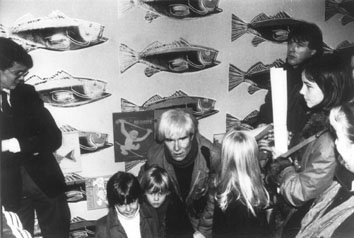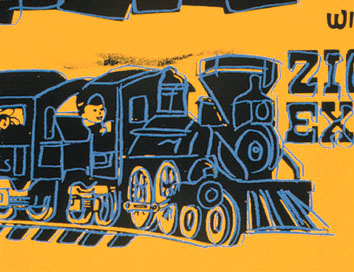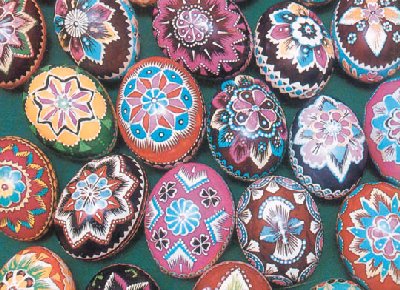


Playing at The Warhol
by Jessica Arcand
Andy Warhol’s art has a strong appeal to children. One expert in early
childhood education said recently that for a child, going through the galleries
of The Andy Warhol Museum was like "walking into a giant storybook." There
are vivid colors, and large paintings of simple objects like those in storybooks—huge
flowers, enormous soup cans, large floating silver pillows you can touch,
and bright yellow wallpaper printed with fluorescent pink cows. It’s a
world that is open to a child’s natural sense of play, and it encourages
adults to play as well.

Warhol’s use of humor and irreverence sharpens the attention of adults.
It opens up the psychological space needed for seeing new ideas, and it
spurs imaginative thinking. When being playful we can think out of the
norm, focus irreverently on one thing over another, and juxtapose totally
different objects and ideas. Play is important to the imagination and problem-solving
world of many adults—whether computer scientists, artists, or business
strategists.
As an artist Warhol played continuously, and especially with technology.
His art installations occupy entire rooms, such as the Rain Machine that
uses three-dimensional picture film and gallons of falling water. His Silver
Clouds is a room full of floating mylar balloons filled with helium and
oxygen. Children and adults love it.
 In 1983 Warhol’s
Zurich art dealer, Bruno Bischofberger, asked him to make a series of paintings
for children. In response Warhol created his "Toy Paintings." Warhol chose
for inspiration simple subjects such as monkeys, parrots, fish, dogs, pandas,
circus clowns and toys from his own collection. The paintings were hung
low so children could easily see them on the specially-printed fish wallpaper
that he created. It was a playful exhibition that captured a wonderful
sense of a child’s world, and reflected the childlike freedom of experimentation
that everyone can enjoy.
In 1983 Warhol’s
Zurich art dealer, Bruno Bischofberger, asked him to make a series of paintings
for children. In response Warhol created his "Toy Paintings." Warhol chose
for inspiration simple subjects such as monkeys, parrots, fish, dogs, pandas,
circus clowns and toys from his own collection. The paintings were hung
low so children could easily see them on the specially-printed fish wallpaper
that he created. It was a playful exhibition that captured a wonderful
sense of a child’s world, and reflected the childlike freedom of experimentation
that everyone can enjoy.

Having family fun and playing at The Warhol is easy to do in March and
April.
•Warhol’s Toy Paintings on fish wallpaper, with some of the original
toys he worked from, are on display at the museum beginning on March 11.
•A Family Guide Pack will be available to help families explore the
whole museum at their own pace. There will also be something for older
kids to do on their own.
•The Weekend Factory always welcomes families from 12 to 4:00 p.m. on
Saturdays and Sundays. Named after Warhol’s studios in New York City, the
Factory offers a chance to join in playful exploration of ideas and techniques
used by Warhol. Family members can take black-and-white self-portraits
in a photo-booth, create a toy, learn to silkscreen, take a screen test,
and talk to museum teachers.

•Carpatho-Rusyn Easter Egg
Extravaganza A Special Easter Family Event—Saturday April 4, 12–6 p.m.
Warhol’s own family heritage and the Carpatho-Rusyn tradition of specially
painted eggs inspires this event. Visitors can paint eggs in the rich decorative
style of Rusyn Americans, see demonstrations, meet members of the Warhola
family, participate in workshops, see performances with traditional dances
and costumes and take special tours.
Jessica Arcand is curator of Education at The Andy Warhol Museum.
Copyright 1998 Carnegie Magazine
All rights reserved. Email: carnegiemag@carnegiemuseums.org
Highlights
|
Calendar
|
Back Issues
|
|


 In 1983 Warhol’s
Zurich art dealer, Bruno Bischofberger, asked him to make a series of paintings
for children. In response Warhol created his "Toy Paintings." Warhol chose
for inspiration simple subjects such as monkeys, parrots, fish, dogs, pandas,
circus clowns and toys from his own collection. The paintings were hung
low so children could easily see them on the specially-printed fish wallpaper
that he created. It was a playful exhibition that captured a wonderful
sense of a child’s world, and reflected the childlike freedom of experimentation
that everyone can enjoy.
In 1983 Warhol’s
Zurich art dealer, Bruno Bischofberger, asked him to make a series of paintings
for children. In response Warhol created his "Toy Paintings." Warhol chose
for inspiration simple subjects such as monkeys, parrots, fish, dogs, pandas,
circus clowns and toys from his own collection. The paintings were hung
low so children could easily see them on the specially-printed fish wallpaper
that he created. It was a playful exhibition that captured a wonderful
sense of a child’s world, and reflected the childlike freedom of experimentation
that everyone can enjoy.

